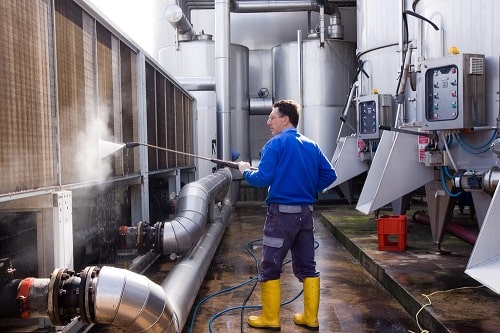New digital and wireless monitoring technology and software offers the chance to make workplaces much safer, but research shows many employers are slow to realise the benefits.
Features
Industry 4.0 – a missed opportunity?
Recent developments in technology, the digital economy, the convergence of physical and cyber systems and the internet of things (IoT) are driving Industry 4.0 (the Fourth Industrial Revolution) ever further and transforming the way we work. In doing so, significant opportunities are being created within a wide range of business sectors and individual organisations to make workplaces smarter.
But Industry 4.0 is about much more than automation and driving efficiency. Ultimately this new smart technology also provides the opportunity to make positive changes to a wide range of strategic workplace issues.
Among these issues, and arguably one of the most compelling areas of potential impact, is the opportunity to improve health and safety and the overall wellbeing of employees in the workplace.
 Industry 4.0 provides the opportunity to make positive changes to a wide range of strategic workplace issues. Photograph: iStock
Industry 4.0 provides the opportunity to make positive changes to a wide range of strategic workplace issues. Photograph: iStock
As new technologies gather pace, growing digitalisation has had a direct impact on how health and safety is practised so that many Industry 4.0 technologies are already being used to directly improve the management of risks to the employee.
Examples might include smart sensors on fixed safety monitoring equipment which proactively alert staff about safety concerns and interact with other systems, as well as identifying maintenance and servicing schedules. Or, in food and drink manufacturing, a gas detection system that not only sounds an alarm when gas readings rise above a safe level but also links to a ventilation system. This means that not only are workers alerted to unsafe gas levels, but automated ventilation is activated by the control system to mitigate any impact.
An added benefit of this type of approach is that systems are more efficient; instead of ventilation fans running permanently, they can be triggered to turn on only when required, based on the condition of the atmosphere, as reported by the gas detection system.
Advances in technology also mean that fixed gas systems are increasingly used in conjunction with individual portable gas detectors which can be carried or worn by a staff member for personal protection. These portable devices allow for data to be transmitted to the fixed control system using Bluetooth or similar technology and to monitor the locations of workers relative to workplace hazards. For example, the technology can raise an alert if someone enters a restricted area or provide rapid information on maintenance and servicing schedules.
 Through analysis of data from various sources, forward-looking predictive assessments become possible. Photograph: iStock
Through analysis of data from various sources, forward-looking predictive assessments become possible. Photograph: iStock
The pandemic has served as a catalyst for far greater use of this type of functionality in a wide variety of settings. For example, the introduction of temperature-monitoring devices which have been used in hospitals and health centres to identify a person’s risk of carrying the coronavirus, therefore protecting staff as well as other patients.
Speed of adoption
However, while the pandemic has further accelerated the take up of these new technologies from a safety perspective, the speed of adoption is far from uniform.
Indeed, it appears that some sectors and organisations are on the verge of being left behind as the Industry 4.0 safety revolution gathers pace. Furthermore, even within those organisations that are using the technology, there are indications that companies are not making the best use of the data generated, therefore missing the opportunity to optimise safety in the working environment.
Recent research carried out by Dräger Safety has shown that less than a third
(28 per cent) of managers believe that their organisations are advanced in the take up of advancing technology (see pie chart left). This figure was slightly higher in the manufacturing and industrial sector where it stood at just over a third (34 per cent) and where there may be more obvious uses for safety data in managing hazardous environments.
Perhaps surprisingly, nearly a quarter (23 per cent) of managers in the oil and gas sector, typically one of the harshest and most dangerous working environments, said that they felt that technology was ‘becoming a key focus now but that their organisation still had a lot to do in this area’ (see table of survey responses above).
On a more optimistic note, there are signs that this position may be starting to change, as a more encouraging 54 per cent of managerial staff questioned said that their organisations are developing and improving all the time when it comes to accessing and acting on the increased availability of safety data (see the pie chart).
This figure rises to 66 per cent in the transport and logistics sector where the use of data from telematics tracking systems and sensors is increasing the efficiency of not only fleet operations but also driver safety. For example, the data is enabling employers to intervene when they identify high-risk behaviours in their fleet drivers and to follow up with additional training if required.
Much can be learnt from this example, which highlights that there is a real opportunity to improve safety standards in the workplace by using the data generated by Industry 4.0 technology to inform safety policy.
For example, when it comes to gas detection, analysing data produced by the gas monitoring and detection devices offers valuable insight that will allow for better, more informed decision-making, both in the short and long term. This data can also be evaluated to serve as the basis for more effective risk assessments and health and safety policies.
Analysis of data
Through analysis of data from various sources, forward-looking predictive assessments become possible. For example, the chances of a gas leak in an industrial facility can be identified at an early stage and timely prevention measures can be initiated – and as a result, the facility’s safety standards are optimised.
However, as the research indicates, many businesses may be unaware of the full potential and even availability of this data; a hugely missed opportunity, and one which demonstrates the important role of continued education around this subject.
Industry 4.0 technology has been adopted in many industries to manage safety in recent times, such as in food and drink manufacturing and in the oil and gas sector. But it is important that those responsible for workplace health and safety across all industry settings understand not only the full range of new technology available to assist with workplace safety, but how they can better exploit existing technology, and utilise it more strategically to support effective solutions to their health and safety requirements.
Dräger’s Safety at Work Report 2021 is at: draegersafetyatwork.blog
Andrew Bligh is System services and training manager at Dräger Safety UK
FEATURES

Machinery at work: why it’s vital to only select plant that offers suitable ingress protection
By Darren Hugheston-Roberts, TÜV SÜD on 10 March 2025
Machinery can deteriorate, malfunction or become unsafe when water or dust enters or if operators wrongly insert tools into the enclosure. It’s therefore vital to purchase plant that has been independently assessed to ensure it is robust enough to cope with the environment and the ways in which it will be used.

HSE inspections target hearing protection and noise control failures
By Peter Wilson, INVC on 07 March 2025
The Health and Safety Executive is currently conducting an inspection programme looking at the adequacy of employers’ noise control measures, while changes to how compensation claims for noise-induced hearing loss are assessed are predicted to result in higher payouts for affected workers. As a result, it is crucial employers review their noise risk reduction approach to ensure it reflects current best practice.

The Health & Safety Event returns to the NEC Birmingham
By Safety Management on 05 March 2025
The free-to-attend Health & Safety Event returns to the NEC in Birmingham on 8–10 April 2025, providing a superb opportunity for occupational health and safety (OSH) practitioners to access the latest products and solutions and expand their knowledge and expertise.



